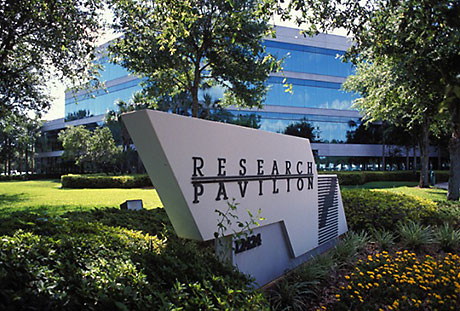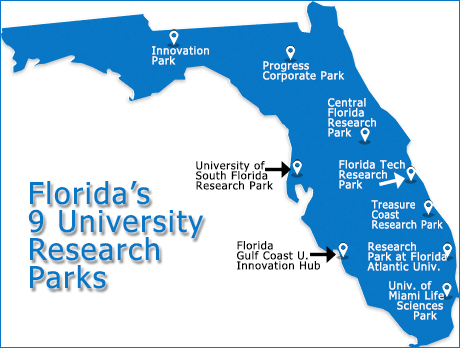As critical components of an innovation economy, Florida’s university research parks help develop advanced technologies into commercial products. Further developing these research parks would produce high-wage jobs, diversify the economy, and keep graduates of Florida universities in our state.
Florida is home to more university research parks than any other state in the nation. These research parks create high-skilled, high-wage jobs, usually in the STEM fields (Science, Technology, Engineering, and Mathematics), and retain talented Florida university graduates. Their members also provide an exchange of technologies and best practices among all parks through the Florida Research Parks Network (FRPN).
The nine university research parks, located throughout the state, attract companies from a variety of industries, including aerospace, cyber security, pharmaceuticals, modeling and simulation technologies, and information technology. The largest of these parks is the Central Florida Research Park (photo below), which is also the fourth-largest in the United States by number of companies, and the seventh-largest by number of employees, with approximately 10,000 employees.

Research Parks’ Role in the Innovation Economy
Likely the most well-known university research park in North America is the Research Triangle Park in North Carolina. Started in 1959, the Park was an experiment in changing an entire state’s economy by investing in the collaboration between universities, the state government, and the private sector. Research Triangle Park remains the largest in North America, one of the largest in the world, and one of the most successful. Many current research parks are modeled on this innovative collaboration.
Research parks host growth-stage and mature companies that benefit from enduring linkages to a university. Affiliations take many forms from sponsoring research, and employing interns, to teaching at the university or being part of an industry advisory council. Many research parks also host incubators that typically concentrate on recent research and often have research laboratories present on the facility. Research parks link researchers and “technology generators” with the marketplace. However, what makes university research parks different from other technology parks, according to a 2013 Association of University Research Parks (AURP) report,1is that these are usually developed by, or in collaboration with, a leading researchinstitution, such as one or several universities, a national laboratory, or another source of technology. Research can be developed by university faculty, students, graduates, and community members.
"University Research Parks in Florida"
Although university research parks and incubators offer varying services to their tenants, many offer help to companies in the form of relationship building between the companies and researchers, help with business planning, and access to capital providers. The AURP survey indicates that critical to the overall success of the park is the commitment of the leadership of the associated university, as well as the acceptance of the local economic development community.
The survey also indicates that research parks have as their primary objectives “to create an environment that encourages innovation and entrepreneurship,” followed closely by the response of “offering a place for faculty and students to work with industry.”
The quantitative results of surveys show that, on average, each incubator produced nearly 9 new businesses that had graduated from their program over the past 5 years. Further results show that 26 percent of the graduate businesses had stayed in the affiliated research park and 43 percent remained in the same region. Other interesting findings include that only 12 percent of companies left the region of the research park and only 19 percent were no longer in business. This is a much better survival rate than the average startup company, whose 5-year survival rate is less than 50 percent.
Private-sector employment in the university research parks in North America averages 79 percent of the total. Only 10 percent are college and university-funded, and around 9 percent are government jobs. The Battelle report indicates a jobs multiplier of 2.48, showing that these types of jobs in university research parks have a substantial multiplier effect and create jobs in other categories with indirect and induced demand.
1 Driving Regional Innovation and Growth: Results from the 2012 Survey of North American University Research Parks. Prepared of Association of University Research Parks (AURP) by Battelle Technology Partnership Practice. August 2013.
» NEXT PAGE: Economic Impact of University Research Parks
Economic Impact of University Research Parks
University research parks attempt to create a compact industry cluster, where all the specialized components of the cluster can work together, providing expertise in multiple fields. The firms benefit from the collaboration opportunities provided by the proximity of the components of the innovation process. The universities benefit from the opportunities to train students, the opportunities for the faculty to consult, and by helping faculty learn best practices. When these components are present, researchers come to these areas because jobs and research facilities are there; and companies come because talent and potential partners are there.
Investors also come, because when the process is working, new commercial technologies are being spun out of the research findings. The jobs in university research parks also support the indirect and induced job creation in their regional economies. Often companies that supply research parks will relocate to an area near the park, creating jobs in the region. Demand from the employees of the parks creates additional jobs in many industries, including production and services.

The Research Park at Florida Atlantic University
One example of a dynamic university research park in Florida is the Research Park at Florida Atlantic University (FAU). The Research Park is a special independent district and is independent of FAU.
The Research Park has a broad mix of organizations that collaborate in developing companies to advance the Florida economy. The Research Park created the Technology Business Incubator, which hosts the investor network New World Angels, and the Institute for the Commercialization for Public Research. This is in addition to more than 30 startup and 22 growth technology companies, which together employ more than 1,300 Floridians.
The Research Park at Florida Atlantic University is working with FAU to integrate the Adams Center for Entrepreneurship in the FAU College of Business into the Research Park. The new initiative would help the faculty, students, and companies validate new technologies, fund them, and get them to market quickly, creating more new products and sustainable jobs.
The President and CEO of Research Park at FAU Andrew Duffell says, “A research park is the critical interface between academia and the private sector. Innovative companies recognize the opportunity to engage the university community, and offer ways for faculty and students to experiment with new concepts in a real-world environment.”
» NEXT PAGE: Conclusion
Conclusion
Florida is home to more university research parks than any other state in the nation.
They are an important part of Florida’s innovation economy, because they create high-skilled, high-wage jobs, and keep Florida graduates in the state.
TAXWATCH CENTER FOR COMPETITIVE FLORIDA ADVISORY BOARD
BOARD CHAIRMAN
SENATOR GEORGE LEMIEUX
Chairman of the Board, Gunster
BOARD MEMBERS
MR. JOHN B. ZUMWALT III
President, thezumwaltcompany
Florida TaxWatch Chairman & Immediate Past Chair, CCF Advisory Board
"University Research Parks in Florida"
WILLIAM E. CARLSON, JR
President, Tucker/Hall
MR. MARSHALL CRISER, III
President, AT&T Florida
Immediate Past Chairman, Florida TaxWatch
MR. DOUG DAVIDSON
Market Executive, Bank of America Merrill Lynch
MR. J. CHARLES GRAY
Chairman, GrayRobinson Law Firm
MR. JON FERRANDO
Executive VP & General Counsel, AutoNation, Inc.
GOVERNOR BOB MARTINEZ
Sr. Policy Advisor, Holland & Knight
MR. DAVE MCINTOSH
Trustee, BlueField Ranch Mitigation Bank Trust
MR. JAMES M. REPP
Senior VP, AvMed Health Plans
MS. MICHELLE A ROBINSON
President, SouthEast Region, Verizon
MR. DAVID A. SMITH
Former Chairman, Florida TaxWatch
MR. MICHAEL SOLE
VP for State Governmental Affairs, Florida Power & Light
TRACY WILLIS
Vice President, The Walt Disney Company
Economic Commentary written by
Jerry D. Parrish, Ph.D., Chief Economist, and Executive Director of the Center for Competitive Florida, with assistance from Jennifer Linares, MS, Research Analyst.
Robert Weissert, Chief Research Officer & General Counsel
Chris Barry, Director of Publications
John Zumwalt, III, Chair, Florida TaxWatch
Sen. George LeMieux Chair, Center for Competitive Florida
Dominic M. Calabro, President, CEO, Publisher, and Editor
Florida TaxWatch Research Institute, Inc.
www.floridataxwatch.org
Copyright © Florida TaxWatch, February 2014













